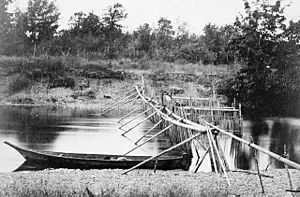Quamichan facts for kids
The Quamichan (pronounced Kwah-mee-chan) people are a traditional group of the Coast Salish. They are also known as the Cowichan, which comes from their word Qu'wutsun, meaning "warm place." They live in the Cowichan Valley on Vancouver Island, near the city of Duncan, British Columbia.
Today, the Quamichan are part of the Cowichan Tribes. This is a larger group that includes several other peoples from the Cowichan area.
Contents
A Look Back in Time
Village Life and Leaders
When Europeans first arrived, Quamichan was the biggest and richest of the eight Cowichan villages. This was partly because of strong leaders like Tzouhalem. He was a powerful chief who once led an attack on Hudson's Bay Company's Fort Victoria in 1844. This attack lasted for two days.
The original name of this village was kwómetsen. This means 'humpback' or 'hunchback'. It comes from a Cowichan story about a giantess with a hunchback. She would put children in a basket and cover their eyes with sticky pitch before eating them. The English name we use today is 'Quamichan'.
How Big Was the Village?
Historical records show that the Quamichan village was very large. It stretched for five kilometers along the Cowichan River. It went from above Quamichan Creek almost down to Comiaken village. When the first count was done after Europeans arrived, about 1,700 people lived there.
Later, the British Colony of Vancouver Island named the area north and west of Cowichan Bay as the Quamichan District. This area is still part of the system used to name and track land ownership.
Traditions and Changes
The Quamichan people had strong cultural traditions, like their annual Winter Dances. Even though missionaries and government agents tried to stop events like the potlatch, these traditions continued. A potlatch is a special gathering where gifts are given and ceremonies are held. People would gather with their families and villages for dances and ceremonies well into the 1900s.
In earlier times, the Quamichan people got their food by fishing, hunting, and gathering wild berries and roots. By the 1900s, their lives changed. They started farming, continued fishing and hunting, and also worked on the railway and in canneries.
Sadly, diseases like Smallpox greatly reduced the Quamichan population. From about 1,000 people in the mid-1800s, their numbers dropped to 300 by 1901 and 260 by 1909.
Beliefs and Faith
Catholic priests first visited the Quamichan people in 1847. More people became Catholic after the Oblate Fathers arrived in Victoria in 1857. In 1864, the Sisters of Saint Anne opened the Cowichan Convent School in Quamichan. This school was for Indigenous girls. By 1909, about 200 Quamichan people were Catholic, and 60 were Methodist.



